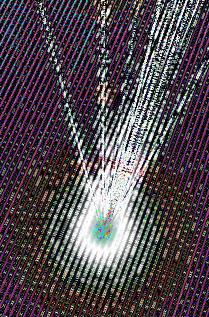Light used to bend electrons
 Researchers say it may be possible to change the electrical properties of a material using light.
Researchers say it may be possible to change the electrical properties of a material using light.
The way electrons flow in materials determine its electronic properties. For example, when a voltage is sustained across a conducting material, electrons start flowing, generating an electrical current.
These electrons are often thought to flow in straight paths, but these are not the only trajectories electrons can take. When a magnetic field is applied, the electrons no longer travel in straight paths along the electric field, but in fact, they bend.
Researchers have wondered whether it is possible to bend electrons without applying a magnetic field.
In a new study, experts report that circular polarised light can induce bent electronic flows in bilayer graphene.
In bilayer graphene, there are two pockets of electron valleys. When a perpendicular electric field is applied, the quantum geometrical properties of electrons in these two valleys can cause them to bend in opposite directions
In the new study, an international team of scientists found that by applying circular polarised infrared light onto the bilayer graphene device, they were able to selectively excite one specific valley population of electrons in the material, which generated a photovoltage perpendicular to the usual electron flow.
This development is significant because conventional photodetectors often require large voltage biases that can lead to “dark currents” that flow even when there is no light.
The results of the study open a new realm of detection and imaging applications.
“Such discovery could have major implications in applications for infrared and terahertz sensing since bilayer graphene can be transformed from semimetal to semiconductor with a very small bandgap, so it can detect photons of very small energies,” says researcher Dr Frank Koppens.
It may be also useful, for example, for imaging in space, medical imaging such as for tissue skin cancer, or even for security applications including the quality inspection of materials.
The full study is accessible here.







 Print
Print